
Mentha is a genus of plants in the family Lamiaceae. The exact distinction between species is unclear; it is estimated that 13 to 24 species exist. Hybridization occurs naturally where some species range overlap. Many hybrids and cultivars are known.

Peppermint is a hybrid mint, a cross between watermint and spearmint. Indigenous to Europe and the Middle East, the plant is now widely spread and cultivated in many regions of the world. It is occasionally found in the wild with its parent species.

Spearmint, also known as garden mint, common mint, lamb mint and mackerel mint, is a species of mint, Mentha spicata, native to Europe and southern temperate Asia, extending from Ireland in the west to southern China in the east. It is naturalized in many other temperate parts of the world, including northern and southern Africa, North America and South America. It is used as a flavouring in food and herbal teas. The aromatic oil, called oil of spearmint, is also used as a flavouring and sometimes as a scent.
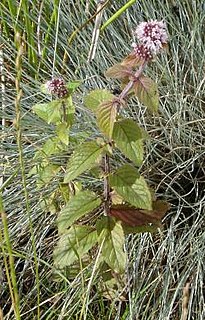
Mentha aquatica is a perennial flowering plant in the mint family Lamiaceae. It grows in moist places and is native to much of Europe, northwest Africa and southwest Asia.
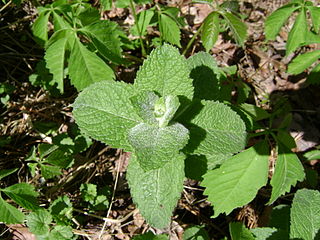
Mentha suaveolens, the apple mint, pineapple mint, woolly mint or round-leafed mint, is a member of the mint family Lamiaceae. It is native to southern and western Europe including the Mediterranean region. It is a herbaceous, upright perennial plant that is most commonly grown as a culinary herb or for ground cover.
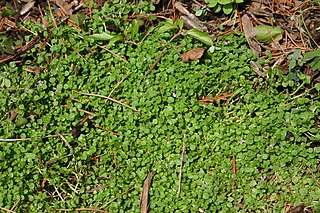
Mentha requienii, or Corsican mint, is a herb and species of mint, native to Corsica, Sardinia, and mainland Italy, and naturalized in Portugal and in the British Isles. It is a very low-growing species with bright green leaves and a strong minty aroma.

Mentha arvensis, the corn mint, field mint, or wild mint, is a species of flowering plant in the mint family Lamiaceae. It has a circumboreal distribution, being native to the temperate regions of Europe and western and central Asia, east to the Himalaya and eastern Siberia, and North America. Mentha canadensis, the related species, is also included in Mentha arvensis by some authors as two varieties, M. arvensis var. glabrata Fernald and M. arvensis var. piperascens Malinv. ex L. H. Bailey.

Eau de Cologne mint, also known as orange mint and bergamot mint, is a cultivated mint. In a 1970 study, most plants were found to be male sterile forms of Mentha aquatica, so were regarded as Mentha aquatica var. citrata, although in England the hybrid Mentha × piperita was found. The Royal Horticultural Society treats eau de Cologne mint as Mentha × piperita f. citrata. The World Checklist of Selected Plant Families sinks both scientific names into Mentha aquatica.

Mentha canadensis is a species of mint native to North America and the eastern part of Asia. In North America, it is commonly known as Canada mint, American wild mint, and in Asia as Chinese mint, Sakhalin mint, Japanese mint, and East Asian wild mint. The flowers are bluish or have a slight violet tint. The plant is upright, growing to about 4–18 in (10–46 cm) tall. Leaves grow opposite from each other, and flower bunches appear in the upper leaf axils. The mint grows in wet areas but not directly in water, so it will be found near sloughs, and lake and river edges. Plants bloom from July to August in their native habitats.
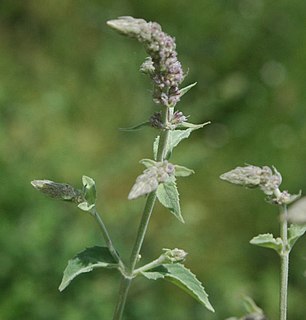
Mentha longifolia var. asiatica is known by the common name Asian mint. It is a variety of the mint species Mentha longifolia. It has also been treated as the separate species, Mentha asiatica and Mentha vagans.
Mentha dahurica is known by the common name of Dahurian thyme. It is a mint species within the genus Mentha, native to Siberia, the Russian Far East, Japan, and northeastern China.
Mentha diemenica is known by the common name of slender mint. The species is named after Van Diemen's Land, which is now called Tasmania. It is a mint species within the genus Mentha, native not only to Tasmania but also to Queensland, New South Wales, Victoria, and South Australia.
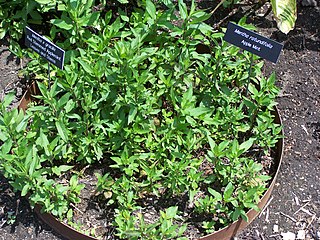
The mint hybrid Mentha × gracilis is known by the common names of gingermint, redmint and Scotchmint in Europe, in North America it is known as Scotch spearmint and is cultivated for its essential oil, used to flavour spearmint chewing gum. It is a mint species within the genus Mentha, a sterile hybrid between Mentha arvensis (cornmint) and Mentha spicata.

Mentha satureioides, commonly known as native pennyroyal or creeping mint, is a species of herbaceous perennial native to southern + eastern Australia. It was first described by prolific botanist Robert Brown in 1810.
Mentha darvasica is a mint species within the genus Mentha, native to Darvaz, Tajikistan. The species was recorded by Russian botanist Antonina Borissova in 1954.
Mentha alaica is a mint species within the genus Mentha, native to the Pamir-Alay mountain range within Tajikistan and Kyrgyzstan. The species was recorded by Russian botanist Antonina Borissova in 1954.
Mentha pamiroalaica is a mint species within the genus Mentha, endemic to the Gissar Range in Tajikistan. The species was recorded by Russian botanist Antonina Borissova in 1954.
Mentha atrolilacina, or slender mint, is a species within the Mentha (mint) genus, endemic to southeastern South Australia. It has been identified only within the Honans Native Forest Reserve, near Mount Gambier, South Australia. Prior to its identification in 2010, specimens of M. atrolilacina had been considered part of the related species Mentha diemenica. The species was discovered by the South Australian Seed Conservation Centre (SASCC).

Mentha gattefossei is a plant species in the genus Mentha, endemic to the Atlas Mountains of Morocco. It was first described by French botanist René Maire in 1922. Harvested for its essential oil, M. gattefossei has seen use in traditional medicine, pest control and as a food seasoning.
Mentha japonica, is a plant species in the genus Mentha, endemic to the islands of Hokkaido and Honshu, Japan. Initially described as Micromeria japonica by Friedrich Anton Wilhelm Miquel, it was first identified under its present name by Japanese botanist Tomitaro Makino in 1906. A relatively rare plant, it is classified by the Japanese Ministry of Environment as a Near Threatened species.












